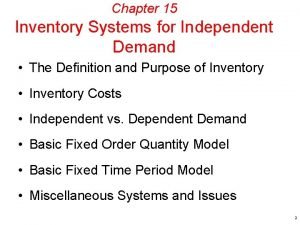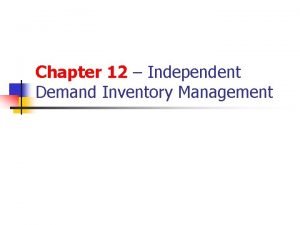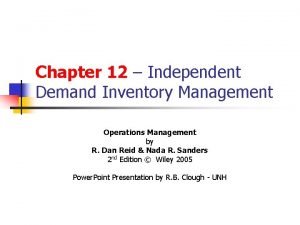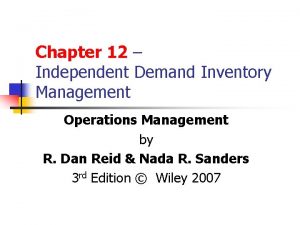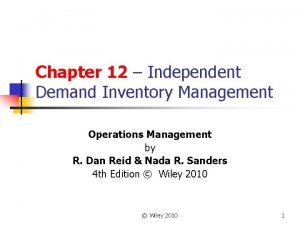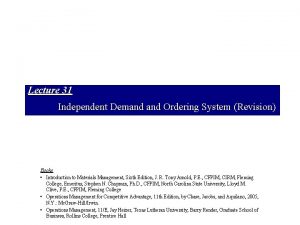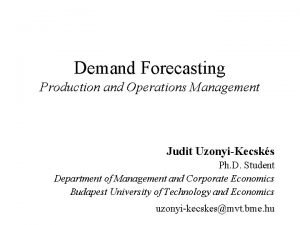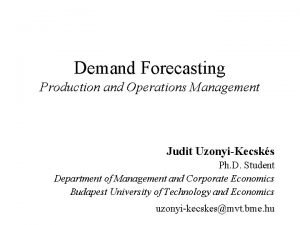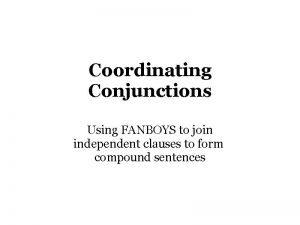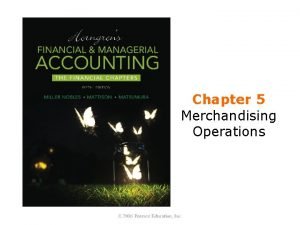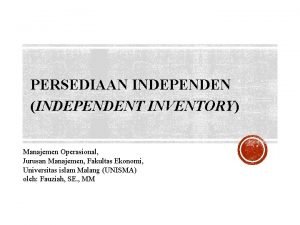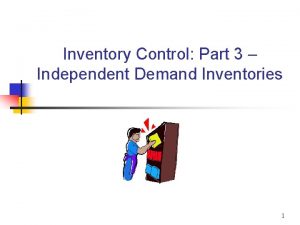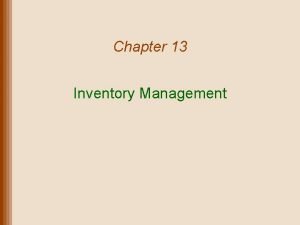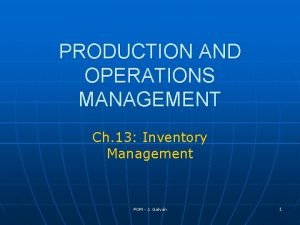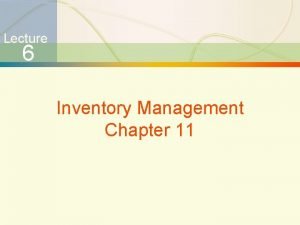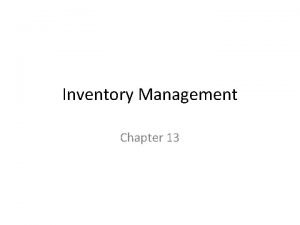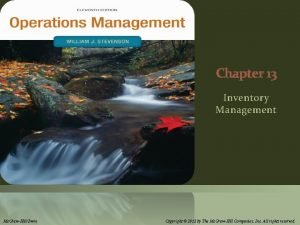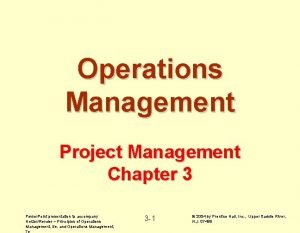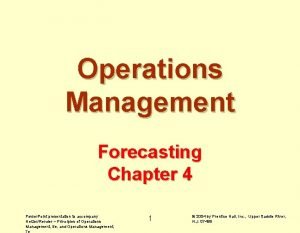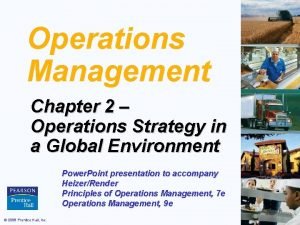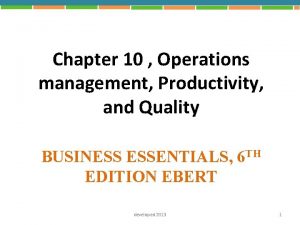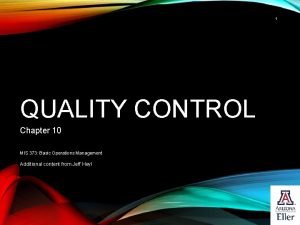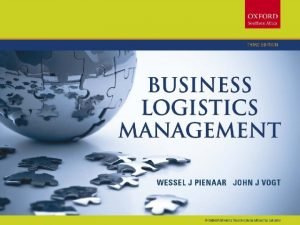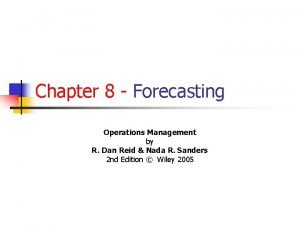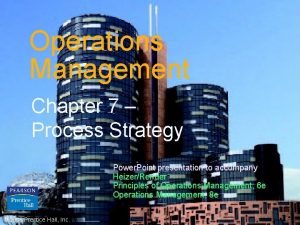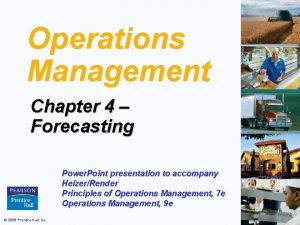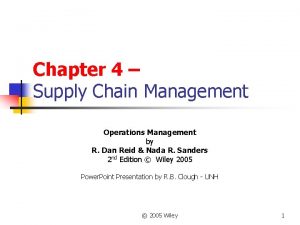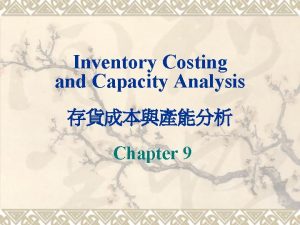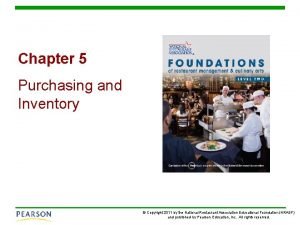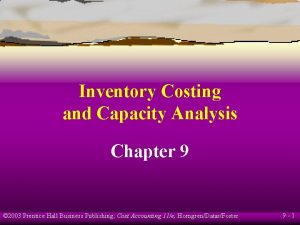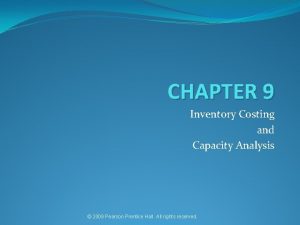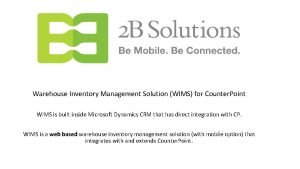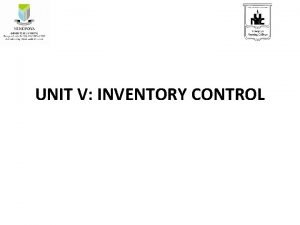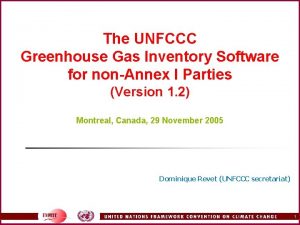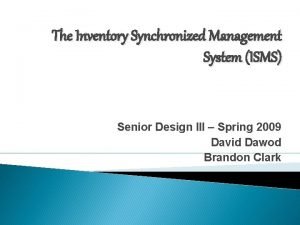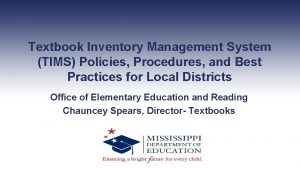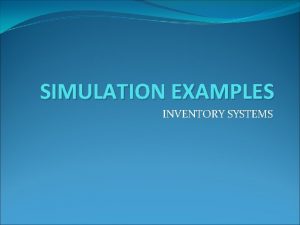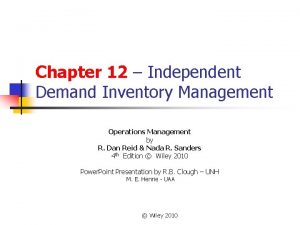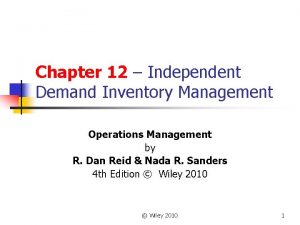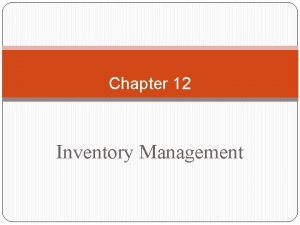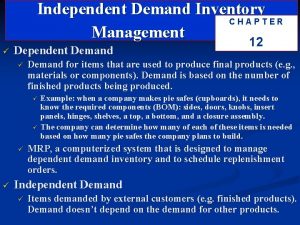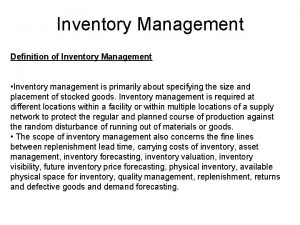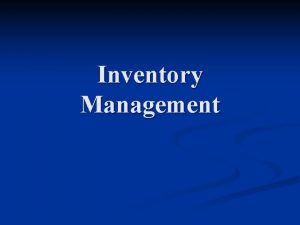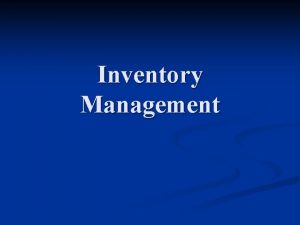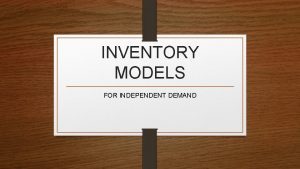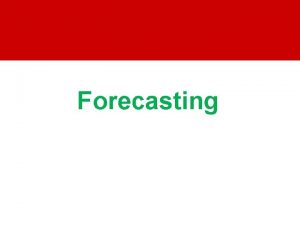Chapter 12 Independent Demand Inventory Management Operations Management

























































- Slides: 57

Chapter 12 – Independent Demand Inventory Management Operations Management by R. Dan Reid & Nada R. Sanders 3 rd Edition © Wiley 2007 Power. Point Presentation by R. B. Clough – UNH M. E. Henrie - UAA © Wiley 2007

Learning Objectives n n n Describe the different types and use of inventory Describe the objectives of inventory management Calculate inventory performance measures Understand relevant costs associated with inventory Calculate order quantities © Wiley 2007

Learning Objectives Continued n n n Understand how to justify smaller order sizes Calculate appropriate safety stock inventory policies Calculate order quantities for single-period inventory Perform ABC inventory control and analysis Understand the role of cycle counting in inventory record accuracy © Wiley 2007

Definitions n n Inventory-A physical resource that a firm holds in stock with the intent of selling it or transforming it into a more valuable state. Inventory System- A set of policies and controls that monitors levels of inventory and determines what levels should be maintained, when stock should be replenished, and how large orders should be

Zero Inventory? n n n Reducing amounts of raw materials and purchased parts and subassemblies by having suppliers deliver them directly. Reducing the amount of works-in process by using just-in-time production. Reducing the amount of finished goods by shipping to markets as soon as possible.

Types of Inventory n Inventory comes in many shapes and sizes such as n n n Raw materials – purchased items or extracted materials transformed into components or products Components – parts or subassemblies used in final product Work-in-process – items in process throughout the plant Finished goods – products sold to customers Distribution inventory – finished goods in the distribution system © Wiley 2007

Types of Inventory © Wiley 2007

Uses of Inventory n n n Anticipation or seasonal inventory Fluctuation Inventory or Safety stock: buffer demand fluctuations Lot-size or cycle stock: take advantage of quantity discounts or purchasing efficiencies Transportation or Pipeline inventory Speculative or hedge inventory protects against some future event, e. g. labor strike Maintenance, repair, and operating (MRO) inventories © Wiley 2007

Reasons for Inventories n n n n Improve customer service Economies of purchasing Economies of production Transportation savings Hedge against future Unplanned shocks (labor strikes, natural disasters, surges in demand, etc. ) To maintain independence of supply chain

Inventory and Value n Remember this? n n Quality Speed Flexibility Cost

Nature of Inventory: Adding Value through Inventory n n Quality - inventory can be a “buffer” against poor quality; conversely, low inventory levels may force high quality Speed - location of inventory has gigantic effect on speed Flexibility - location, level of anticipatory inventory both have effects Cost - direct: purchasing, delivery, manufacturing indirect: holding, stockout. HR systems may promote this-3 year postings

Objectives of Inventory Management n n Provide desired customer service level Customer service is the ability to satisfy customer requirements n n Percentage of orders shipped on schedule Percentage of line items shipped on schedule Percentage of dollar volume shipped on schedule Idle time due to material and component shortages © Wiley 2007

Inventory Management Objectives Provide for cost-efficient operations: n n Buffer stock for smooth production flow Maintain a level work force Allowing longer production runs & quantity discounts Minimum inventory investments: n n Inventory turnover Weeks, days, or hours of supply © Wiley 2007

Independent Demand n n n Independent demand items are finished products or parts that are shipped as end items to customers. Forecasting plays a critical role Due to uncertainty- extra units must be carried in inventory

Dependent Demand n n Dependent demand items are raw materials, component parts, or subassemblies that are used to produce a finished product. MRP systems---next week

Customer Service Level Examples n Percentage of Orders Shipped on Schedule n n n Percentage of Line Items Shipped on Schedule n n n Good measure if orders have similar value. Does not capture value. If one company represents 50% of your business but only 5% of your orders, 95% on schedule could represent only 50% of value Recognizes that not all orders are equal, but does not capture $ value of orders. More expensive to measure. Ok for finished goods. A 90% service level might mean shipping 225 items out of the total 250 line items totaled from 20 orders scheduled Percentage Of Dollar Volume Shipped on Schedule n Recognizes the differences in orders in terms of both line items and $ value © Wiley 2007

Inventory Investment Measures Example: The Coach Motor Home Company has annual cost of goods sold of $10, 000. The average inventory value at any point in time is $384, 615. Calculate inventory turnover and weeks/days of supply. n Inventory Turnover: n Weeks/Days of Supply: © Wiley 2007

Relevant Inventory Costs Item Cost Includes price paid for the item plus other direct costs associated with the purchase Holding Costs Include the variable expenses incurred by the plant related to the volume of inventory held e. g. 15 -25% The higher of the cost of capital or the opportunity cost for the company Capital Costs © Wiley 2007

Relevant Inventory Costs Ordering Cost Shortage Costs Fixed, constant dollar amount incurred for each order placed Loss of customer goodwill, back order handling, and lost sales Risk costs Obsolescence, damage, deterioration, theft, insurance and taxes Included the variable expenses for space, workers, and equipment related to the volume of inventory held Storage costs © Wiley 2007

Determining Order Quantities Lot-for-lot Order exactly what is needed Fixed-order Specifies the number of units to order quantity whenever an order is placed Min-max system Order n periods Places a replenishment order when the on-hand inventory falls below the predetermined minimum level. Order quantity is determined by total demand for the item for the next n © Wiley 2007 periods

Examples of Ordering Approaches © Wiley 2007

Three Mathematical Models for Determining Order Quantity n Economic Order Quantity (EOQ or Q System) n n n Economic Production Quantity (EPQ) n n An optimizing method used for determining order quantity and reorder points Part of continuous review system which tracks onhand inventory each time a withdrawal is made A model that allows for incremental product delivery Quantity Discount Model n Modifies the EOQ process to consider cases where quantity discounts are available © Wiley 2007

Economic Order Quantity n EOQ Assumptions: n n n Demand is known & constant no safety stock is required Lead time is known & constant No quantity discounts are available Ordering (or setup) costs are constant All demand is satisfied (no shortages) The order quantity arrives in a single shipment © Wiley 2007

Total Annual Inventory Cost with EOQ Model n Total annual cost= annual ordering cost + annual holding costs © Wiley 2007

Continuous (Q) Review System Example: A computer company has annual demand of 10, 000. They want to determine EOQ for circuit boards which have an annual holding cost (H) of $6 per unit, and an ordering cost (S) of $75. They want to calculate TC and the reorder point (R) if the purchasing lead time is 5 days. n EOQ (Q) n Reorder Point (R) n Total Inventory Cost (TC) © Wiley 2007

Economic Production Quantity (EPQ) n Same assumptions as the EOQ except: inventory arrives in increments & is drawn down as it arrives © Wiley 2007

EPQ Equations n Total cost: n Maximum inventory: n n n d=avg. daily demand rate p=daily production rate Calculating EPQ © Wiley 2007

EPQ Problem: HP Ltd. Produces its premium plant food in 50# bags. Demand is 100, 000 lbs. per week and they operate 50 wks. each year and HP can produce 250, 000 lbs. per week. The setup cost is $200 and the annual holding cost rate is $. 55 per bag. Calculate the EPQ. Determine the maximum inventory level. Calculate the total cost of using the EPQ policy. © Wiley 2007

EPQ Problem: HP Ltd. Produces its premium plant food in 50# bags. Demand is 100, 000 lbs. per week and they operate 50 wks. each year and HP can produce 250, 000 lbs. per week. The setup cost is $200 and the annual holding cost rate is $. 55 per bag. Calculate the EPQ. Determine the maximum inventory level. Calculate the total cost of using the EPQ policy. © Wiley 2007

Quantity Discount Model n Same as the EOQ model, except: n n Unit price depends upon the quantity ordered The total cost equation becomes: © Wiley 2007

Quantity Discount Procedure n n Calculate the EOQ at the lowest price Determine whether the EOQ is feasible at that price n n Will the vendor sell that quantity at that price? If yes, stop – if no, continue Check the feasibility of EOQ at the next higher price Continue to the next slide. . . © Wiley 2007

QD Procedure n n n (continued) Continue until you identify a feasible EOQ Calculate the total costs (including total item cost) for the feasible EOQ model Calculate the total costs of buying at the minimum quantity required for each of the cheaper unit prices Compare the total cost of each option & choose the lowest cost alternative Any other issues to consider? © Wiley 2007

Quantity Discount Example: Collin’s Sport store is considering going to a different hat supplier. The present supplier charges $10 each and requires minimum quantities of 490 hats. The annual demand is 12, 000 hats, the ordering cost is $20, and the inventory carrying cost is 20% of the hat cost, a new supplier is offering hats at $9 in lots of 4000. Who should he buy from? n n n EOQ at lowest price $9. Is it feasible? Since the EOQ of 516 is not feasible, calculate the total cost (C) for each price to make the decision 4000 hats at $9 each saves $19, 320 annually. Space? © Wiley 2007

Safety Stock and Service Levels n If demand or lead time is uncertain, safety stock can be added to improve order-cycle service levels n n n R = d. L +SS Where SS =zσd. L, and Z is the number of standard deviations and σd. L is standard deviation of the demand during lead time Order-cycle service level n The probability that demand during lead time will not exceed on-hand inventory n A 95% service level (stockout risk of 5%) has a Z=1. 645 © Wiley 2007

Periodic Review Systems n n Orders are placed at specified, fixed-time intervals (e. g. every Friday), for a order size (Q) to bring onhand inventory (OH) up to the target inventory (TI), similar to the min-max system. Advantages are: n n n No need for a system to continuously monitor item Items ordered from the same supplier can be reviewed on the same day saving purchase order costs Disadvantages: n n n Replenishment quantities (Q) vary Order quantities may not quality for quantity discounts On the average, inventory levels will be higher than Q systems-more stockroom space needed © Wiley 2007

Periodic Review Systems: Calculations for TI n n Targeted Inventory level: TI = d(RP + L) + SS d = average period demand RP = review period (days, wks) L = lead time (days, wks) SS = zσRP+L Replenishment Quantity (Q)=TI-OH © Wiley 2007

P System: an auto parts store calculated the EOQ for Drive Belts at 236 units and wants to compare the Total Inventory Costs for a Q vs. a P Review System. Annual demand (D) is 2704, avg. weekly demand is 52, weekly σ is 1. 77 belts, and lead time is 3 weeks. The annual TC for the Q system is $229; H=$97, S=$10. n Review Period n Target Inventory for 95% Service Level n Average On-Hand OHavg= TI-d. L=424 -(52 belts)(3 wks) = 268 belts n Annual Total Cost (P System) © Wiley 2007

Single Period Inventory Model n The SPI model is designed for products that share the following characteristics: n n Sold at their regular price only during a single-time period Demand is highly variable but follows a known probability distribution Salvage value is less than its original cost so money is lost when these products are sold for their salvage value Objective is to balance the gross profit of the sale of a unit with the cost incurred when a unit is sold after its primary selling period © Wiley 2007

SPI Model Example: Tee shirts are purchase in multiples of 10 for a charity event for $8 each. When sold during the event the selling price is $20. After the event their salvage value is just $2. From past events the organizers know the probability of selling different quantities of tee shirts within a range from 80 to 120 Payoff Prob. Of Occurrence Customer Demand # of Shirts Ordered 80 90 Buy 100 110 120 . 20 80 $960 $900 $840 $780 $720 Table . 25 90 . 30 100 . 15 110 . 10 120 $960 $1080 $1020 $ 960 $ 900 $960 $1080 $1200 $1140 $1080 $960 $1080 $1200 $1320 $1260 $960 $1080 $1200 $1320 $1440 Sample calculations: Profit $960 $1040 $1083 $1068 $1026 Payoff (Buy 110)= sell 100($20 -$8) –((110 -100) x ($8 -$2))= $1140 Expected Profit (Buy 100)= ($840 X. 20)+($1020 x. 25)+($1200 x. 30) + ($1200 x. 15)+($1200 x. 10) = $1083 © Wiley 2007

ABC Inventory Classification n n ABC classification is a method for determining level of control and frequency of review of inventory items A Pareto analysis can be done to segment items into value categories depending on annual dollar volume © Wiley 2007

Classifying Inventory Items n n n A Items – very tight control, complete and accurate records, frequent review. typically 20% of the items accounting for 80% of the inventory value-use Q system B Items – less tightly controlled, good records, regular review. typically an additional 30% of the items accounting for 15% of the inventory value-use Q or P C Items – simplest controls possible, minimal records, large inventories, periodic review and reorder. Typically the remaining 50% of the items accounting for only 5% of the inventory value-use P

The AAU Corp. is considering doing an ABC analysis on its entire inventory but has decided to test the technique on a small sample of 15 of its SKU’s. The annual usage and unit cost of each item is shown below © Wiley 2007

(A) First calculate the annual dollar volume for each item © Wiley 2007

B) List the items in descending order based on annual dollar volume. (C) Calculate the cumulative annual dollar volume as a percentage of total dollars. (D) Classify the items into groups © Wiley 2007

Graphical solution For Example 12. 15 showing the ABC classification of materials n n The A items (106 and 110) account for 60. 5% of the value and 13. 3% of the items The B items (115, 105, 111, and 104) account for 25% of the value and 26. 7% of the items The C items make up the last 14. 5% of the value and 60% of the items How might you control each item classification? Different ordering rules for each? © Wiley 2007

Justifying Smaller Order Quantities n n JIT or “Lean Systems” would recommend reducing order quantities to the lowest practical levels Benefits from reducing Q’s: n n n Improved customer responsiveness (inventory = Lead time) Reduced Cycle Inventory Reduced raw materials and purchased components Justifying smaller EOQ’s: Reduce Q’s by reducing setup time (S). “Setup reduction” is a well documented, structured approach to reducing S © Wiley 2007

Inventory Record Accuracy n Inaccurate inventory records can cause: n n n Lost sales Disrupted operations Poor customer service Lower productivity Planning errors and expediting © Wiley 2007

Inventory Record Accuracy n Two methods are available for checking record accuracy n n Periodic counting - physical inventory is taken periodically, usually annually Cycle counting-daily counting of prespecified items provides the following advantages: n n n Timely detection and correction of inaccurate records Elimination of lost production time due to unexpected stock outs Structured approach using employees trained in cycle counting © Wiley 2007

Inventory Management Across the Organization n Inventory management policies affect functional areas throughout n n n Accounting is concerned of the cost implications of inventory Marketing is concerned as stocking decision affect the level of customer service Information Systems is involved to tack and control inventory records © Wiley 2007

Chapter 12 Highlights n Raw materials, purchased components, workin-process, finished goods, distribution inventory and maintenance, repair and operating supplies are all types of inventory. Inventories have several uses: anticipation inventory is built before it is needed; fluctuation stock provides a cushion; cycle stock is a result of the company’s ordering quantity; transportation inventory includes items in transit; speculative inventory is a buildup to protect against some future event and MRO inventory supports daily operations © Wiley 2007

Chapter 12 Highlights n n The objectives of inventory management are to provide the desired level of customer service, to allow cost-efficient operations, and to minimize inventory investment. Customer service can be measured in several ways, including as a percentage of orders shipped on schedule, a percentage of line items shipped on schedule, a percentage of dollar volume shipped on schedule, or idle time due to material and component shortages. Cots-efficient operations are achieved by using inventory as buffer stocks allowing a stable year-round workforce, and spreading the setup cost over a larger number of Inventory performance is measured by turns/supply. Inventory costs include item cost, holding cost, ordering cost, and shortage cost. © Wiley 2007

Chapter 12 Highlights n n (continued) Inventory investment is measured in inventory turnover and/or level of supply. Inventory performance is calculated as inventory turnover or weeks, days, or hours of supply. Relevant inventory costs include items costs, holding costs, and shortage costs. Holding costs include capital costs, storage costs, and risk costs. Ordering costs are fixed costs for placing an order or performing a setup. Shortage costs included costs related to additional paperwork, additional shipping expense, and the intangible cost of lost customer goodwill. © Wiley 2007

Chapter 12 Highlights n n (continued) Lot-for-lot, fixed-order quantity, min-max systems, order n periods, periodic review systems, EOQ models, quantity discount models, and single-period models can be used to determine order quantities. Ordering decisions can be improved by analyzing total costs of an inventory policy. Total costs include ordering cost, holding cost, and material cost © Wiley 2007

Chapter 12 Highlights n n n (continued) Practical considerations can cause a company to not use the optimal order quantity, that is, minimum order requirements Smaller lot sizes give a company flexibility and shorter response times. The key to reducing order quantities is to reduce ordering or setup costs. Calculating the appropriate safety stock policy enables companies to satisfy their customer service objective at minimum costs. The desired customer service level determines the appropriate z value. © Wiley 2007

Chapter 12 Highlights n n n (continued) Inventory decisions about perishable products can be made using the single-period inventory model. The expected payoff is calculated to assist the quantity decision The ABC classification system allows a company to assign the appropriate level of control and frequency of review of an item based on its annual dollar volume Cycle counting is a method for maintaining accurate inventory records. Determining what and when to count are the major decisions © Wiley 2007

Chapter 12 Highlights n n n n (continued) Order Q’s can be determined by using L 4 L, fixed order Q’s, minmax, order n periods, quantity discounts, and single period systems. Ordering decisions can be improved by analyzing TC Smaller lot sizes increase flexibility and reduce response time. Safety stock can be added to reorder point calculations to meet desired service level z value. Inventory decisions about perishable products can be made by using the single-period inventory model. ABC analysis can be used to assign the appropriate level of control and review frequency based on the annual dollar volume of each item. Cycle counting of pre-specified items is an accepted method for maintaining inventory records © Wiley 2007

The End n Copyright © 2007 John Wiley & Sons, Inc. All rights reserved. Reproduction or translation of this work beyond that permitted in Section 117 of the 1976 United State Copyright Act without the express written permission of the copyright owner is unlawful. Request for further information should be addressed to the Permissions Department, John Wiley & Sons, Inc. The purchaser may make back-up copies for his/her own use only and not for distribution or resale. The Publisher assumes no responsibility for errors, omissions, or damages, caused by the use of these programs or from the use of the information contained herein. © Wiley 2007
 Independent demand example
Independent demand example Dependent demand operations management
Dependent demand operations management Independent demand definition
Independent demand definition Independent demand example
Independent demand example Dependent and independent demand in inventory management
Dependent and independent demand in inventory management What is independent demand
What is independent demand Independent demand example
Independent demand example Chapter 12 inventory management
Chapter 12 inventory management Inventory models for independent demand
Inventory models for independent demand Independent demand inventory
Independent demand inventory Demand service
Demand service Demand forecasting operations management
Demand forecasting operations management Demand forecasting in operations management
Demand forecasting in operations management Fanboys connectors
Fanboys connectors Objective of merchandising
Objective of merchandising Rumus eoq dan epq
Rumus eoq dan epq Inventory control diagram
Inventory control diagram Deterministic and stochastic inventory models
Deterministic and stochastic inventory models Measures to correct deficient demand
Measures to correct deficient demand Individual demand vs market demand
Individual demand vs market demand Halimbawa ng demand curve
Halimbawa ng demand curve Module 5 supply and demand introduction and demand
Module 5 supply and demand introduction and demand Demand forecasting managerial economics
Demand forecasting managerial economics Distinguish between individual demand and market demand
Distinguish between individual demand and market demand Sap sales and operations planning ppt
Sap sales and operations planning ppt Chapter 13 inventory management problems and solutions
Chapter 13 inventory management problems and solutions Chapter 13 inventory management
Chapter 13 inventory management Chapter 13 inventory management
Chapter 13 inventory management Chapter 13 inventory management
Chapter 13 inventory management Chapter 13 inventory management
Chapter 13 inventory management Operations management chapter 3 solutions
Operations management chapter 3 solutions Operations management chapter 4 forecasting solutions
Operations management chapter 4 forecasting solutions Global operations strategy options
Global operations strategy options Function of operation manager
Function of operation manager Chapter 3 operations management
Chapter 3 operations management Operations management chapter 10
Operations management chapter 10 Operations management chapter 10 quality control solutions
Operations management chapter 10 quality control solutions Chapter 8 operations management
Chapter 8 operations management Forecasting in operations management
Forecasting in operations management Cross over charts
Cross over charts Operation management chapter 4
Operation management chapter 4 Chapter 11 operations management
Chapter 11 operations management Human resource and job design in operations management
Human resource and job design in operations management Chapter 4 operations management
Chapter 4 operations management Operations management chapter 2
Operations management chapter 2 Demand management and capacity management
Demand management and capacity management Operations and quality management
Operations and quality management What is tqm
What is tqm Inventory costing and capacity analysis
Inventory costing and capacity analysis Chapter 5 purchasing and inventory
Chapter 5 purchasing and inventory Inventory costing and capacity analysis
Inventory costing and capacity analysis Inventory costing and capacity analysis
Inventory costing and capacity analysis Warehouse inventory management solution (wims) nulled
Warehouse inventory management solution (wims) nulled Inventory meaning
Inventory meaning Greenhouse inventory management software
Greenhouse inventory management software Conclusion of inventory management
Conclusion of inventory management Textbook inventory system
Textbook inventory system Inventory simulation examples
Inventory simulation examples



